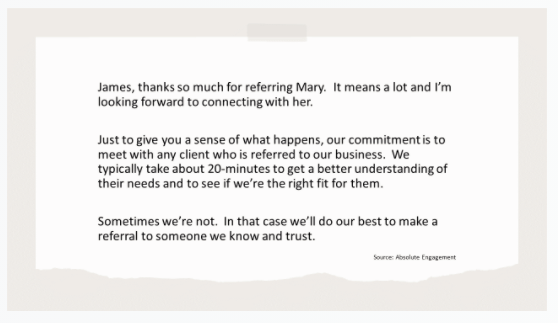The idea of saying no to a referral seems absurd.
When you think about the effort it takes to not only ‘become referable’, through the eyes of your clients, but to translate that into action, how can you even think about saying no?
You can. And you should.
But you already know that.
And yet, when I talk to advisors about the referrals they receive, there seems to be an overwhelming sense of obligation to work with any client who is referred or run the risk of offending someone.
You won’t.
Or perhaps it’s a deep-seated fear that we should never walk away from new business.
You should.
But how do you walk away when the fit isn’t right? More specifically, how do you walk away in a way that feels good for your client, the prospect and for you?
Let’s start by getting real about something.
- Prospective clients don’t want to work with you if the fit isn’t right. They want to work with someone who truly wants to work with them.
- Your clients don’t want you to work with their friends and family if the fit isn’t right. They just want you to help find a solution, which could be a referral to another advisor.
These two, reasonably obvious, statements should make it more comfortable to walk away.
Taking Action
So now that we’re over the sense of obligation (because it’s not real), what can you do?
Help clients understand your referral commitments BEFORE they refer.
In last week’s post, I shared some ideas on providing clients with a sense of your process for following up with referrals that you receive. The goal was to reduce an insidious (and unspoken) source of friction related to a lurking fear regarding your follow-up process.
This idea is an extension of that, but focused on communicating what you will do when a referral is interested in meeting - and what you'll do if the fit simply isn't right. Simply communicating this in advance goes a long way to removing the friction, both for you and for your client.
The core idea, as always, is to articulate your process through the eyes of your clients and prospects.
Consider this approach:

Notice the following:
- You aren’t saying “Our commitment is to meet with any client that meets our asset minimum.” It’s not your clients’ job to know if that’s the case.
- You aren’t saying “We’ll see if they’re right for us. ” Rather you're saying “We’ll see if we’re right for them.” Everything needs to be through the eyes of the client.
- You are saying “Sometimes we’re not the best fit.” Not only does that manage client expectations but could raise a great, natural question. Then who is a good fit?
Remember, clients refer to help a friend or family member solve a problem. You don’t always have to be the solution.

